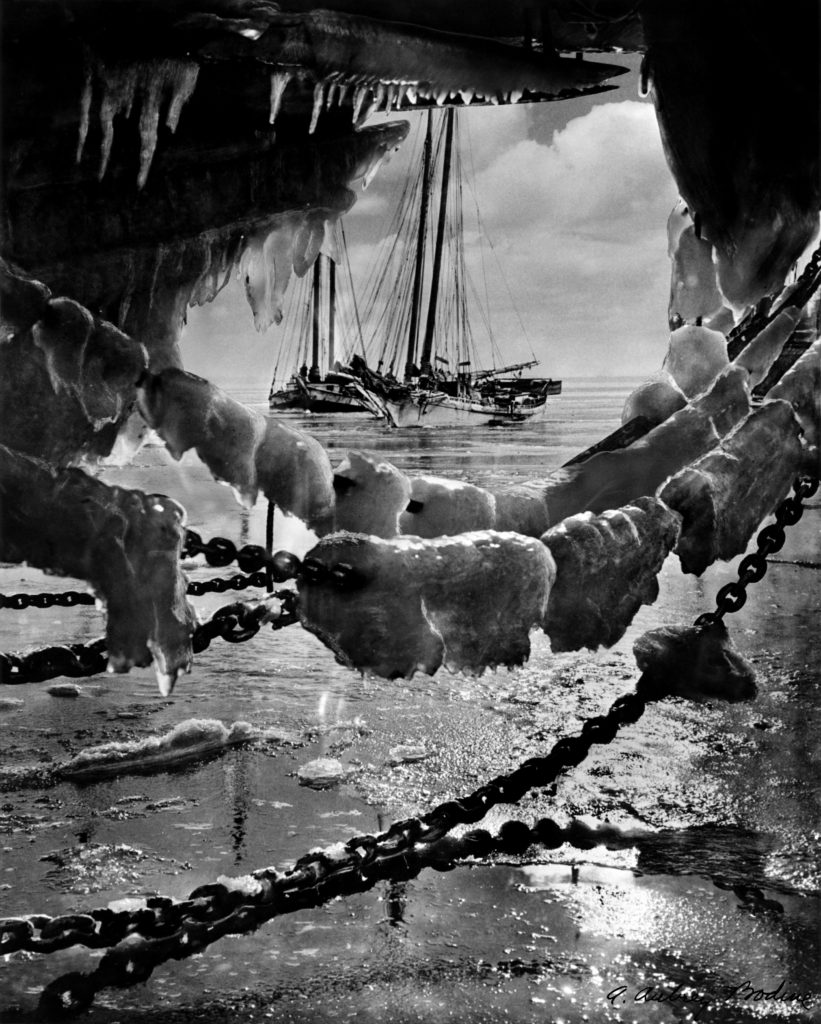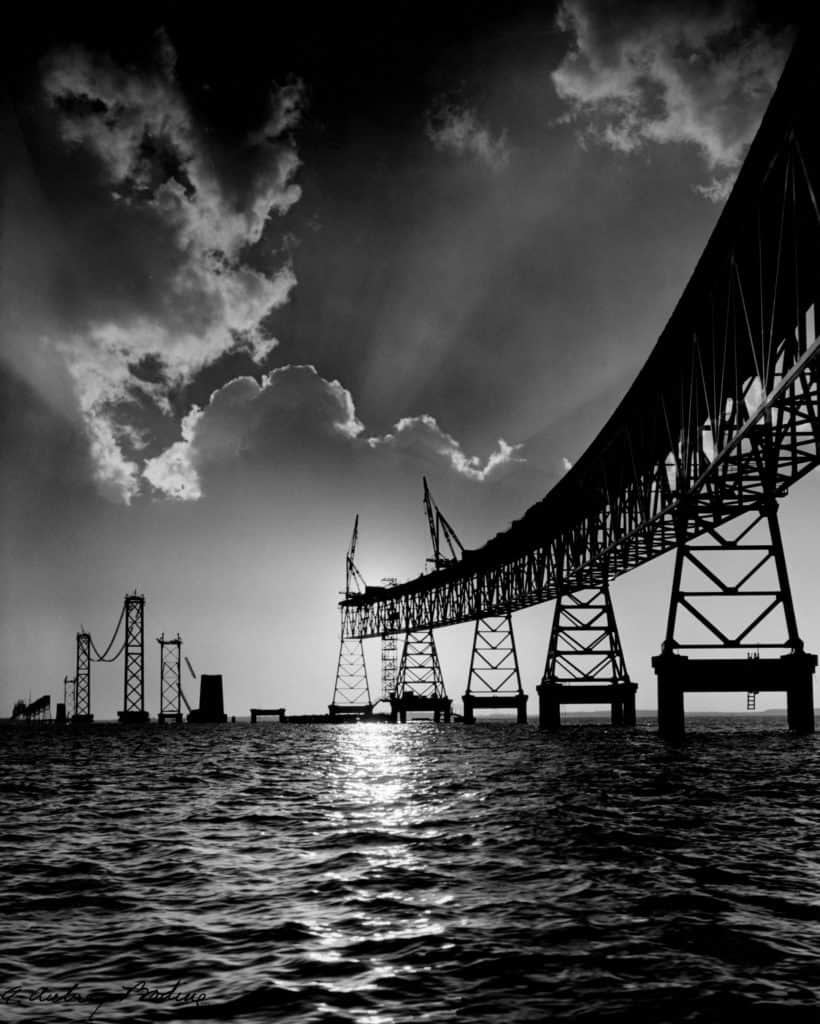Through the Lens

The Mitchell Gallery Hosts Online Exhibit by A. Aubrey Bodine
By Steve Adams
The Chesapeake Bay is inspiring. Countless authors, performers and artists have felt its pull and use its waters, land and people in their artistic expression. Many of these artists prefer the perspective from behind the lens and the Bay region has birthed several well-known photographers such as Charles E. Emery, Jay Fleming, and Marion Warren.
But if you’re interested in seeing a finely-curated collection of photographs that may be less familiar, from a photographer you’ve likely heard of but whose creativity you’ve not yet discovered, look no further than The Mitchell Gallery at St. John’s College.
The gallery, despite being closed for this academic year, is currently hosting its second virtual exhibition, which you can enjoy from the comfort of home. Running through March 21, you can see a newly-curated collection of 25 photographs of Annapolis and Anne Arundel County, taken by A. Aubrey Bodine.
Bodine is the Baltimore-born icon who submitted his first photo to the editor of The Baltimore Sun at just 17 years old as an office boy and gained fame thanks to the many thousands of “documentary pictures” he took of interesting people, places, and things during his 50 years as a photographer and photojournalist with the newspaper.
But the 25 photographs chosen for the Our Town exhibit are not your standard images of familiar landmarks.
“These specific photographs are interesting for a number of reasons,” explains curator Lucinda Edinberg, who selected them after reviewing Bodine’s full archive—“25,000 photographs, at least”—and reading Annapolis: Photographs by A. Aubrey Bodine, a book by Bodine’s daughter, Jennifer, which provided the inspiration for the exhibition.
“For starters, the collection includes some of Bodine’s work as a staff photographer for The Sun, where he earned his bread and butter, but mainly showcases Bodine’s creative side through his work in pictorialism,” she says.

Pictorialism was an aesthetic movement in which photographs were processed in silver gelatin and deliberately manipulated in the dark room in order to emphasize romantic beauty over documented reality—to, as she puts it, “create a mood or atmosphere.”
Pictorialism was popular in the late 19th and 20th centuries due in large part to the work of Alfred Stieglitz, a photographer who wanted his work accepted in the realm of artistic expression and encouraged others to create photos that did more than capture a scene. The style led photographers to impose, switch around, darken, burn out, and highlight additional negatives in all kinds of ways, just as a painter does by moving paint around with different brushes and palette knives, to create a final piece—photo manipulation long before there were computers or Photoshop.
The exhibit of Bodine’s photos gives us a rare look at mid-20th century Maryland. “I tried to choose images that the public hasn’t generally seen,” says Edinberg. “While there are a few in the exhibition that have been very popular and have been available in note cards and photo re-prints, and those of a certain age may even remember a few from the Brown Pages in the Sunday Sun Magazine, I took this as an opportunity to provide some breadth of Bodine’s talent, as well as some visual history of Anne Arundel County and its importance in the agricultural/watershed economy.”
Without giving too much away, the eclectic collection includes black and white photos of tobacco farming, farmers, and fields; trains destined for, and buildings both past and present in, downtown Annapolis; and, of course, sailboats.
Asked to name her favorite photographs, something she says “is like being asked to name a favorite child,” Edinberg offers “The Bullwhackers,” which she describes as “a moving, moody, and deliberate pictorialist piece” showing the use of animal labor in 1953. She also points to “Tobacco Wagon,” a photojournalistic image from 1942. “As with all the photographs in the exhibit, these display Bodine’s range of style. They remind us that he was always keeping design and composition in mind, even in the newspaper work.”
Beyond viewing the photo exhibit online, you can learn more about Bodine and pictorialism through several virtual events on the Mitchell Gallery website:
- Thru March 21: Listen to The A. Aubrey Bodine: Our Town Prerecorded Lecture by Edinberg.
- February 28: Interview and Q&A with Jennifer B. Bodine, who will provide the backstory on the work and creativity of A. Aubrey Bodine’s photography exhibited in salons and the “Brown Pages” of The Baltimore Sun. (3pm)
- March 4: Virtual tour with Edinberg, followed by a discussion of After the Photo-Secession: American Pictorial Photography, 1910–1955 with celebrated photographer Don Dement. (2:30pm)
- March 21: George Winston in concert, which will celebrate and officially close the exhibition with a performance by the Grammy Award-winning pianist. (7pm)
Last but certainly not least, the exhibition also inspired Edinberg and former National Geographic and Discovery Channel photographer Bob Madden to organize and stage a Pictorialist Challenge, a free photography competition running through March 7. Submit up to three photographs, each incorporating at least two pictorialist elements, for critique by award-winning photographers Madden and Wilford Scott; a potential post on the Mitchell Gallery website; and potential inclusion in the Pictorialist Challenge “Reveal” and Discussion on March 14.
“Our exhibitions have always had a Tuesday Try-It, a workshop that gives people the opportunity to learn about the medium, philosophy, or technique of the artists from well-respected instructors in their fields—for example Impressionist artist Abigail McBride, expert book artist Joan Machinchick, well-known printmaker Helen Frederick, illustrator Rob Wood, and Bob Madden—and actually explore it in practice,” explains Edinberg. “I was looking for something similar to do online with the use of photo manipulation, since we couldn’t host a live workshop, and Bob came up with the challenge idea to feature the pictorialist style.”
Reflecting on the impetus for the exhibit, Edinberg says, “It really comes down to ‘why does art matter?’ And even though the gallery is closed physically, we know that our visitors remain interested in art, learning new information, and allowing themselves to reflect on different cultures, media, or styles. I hope our exhibitions continue to provide an interesting, and entertaining, distraction.”
www.sjc.edu/annapolis/mitchell-gallery/exhibits-and-programs/aubrey-bodine-our-town
